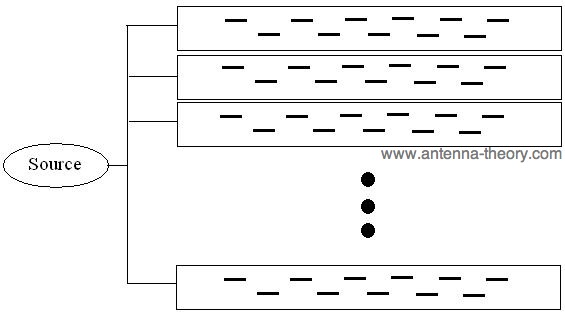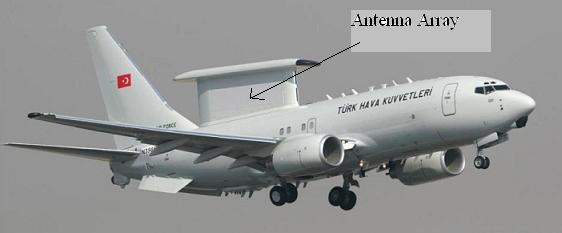Slotted Waveguide Antennas
|
On the previous page on slotted waveguides,
it was shown that for a single waveguide strip, the radiation pattern tends to have a very wide
beamwidth
in the E-plane and
a relatively small beamwidth in the H-plane. The problem arises because the physical dimensions along the E-plane is much shorter
than that along the H-plane (the slotted waveguide is long but thin). In general, a longer antenna (or longer array) produces
a narrower beam. This problem can be circumvented by arranging slotted waveguides in parallel, as shown in Figure 1.
 Figure 1. Array of slotted waveguides fed by a single source. By stacking waveguides as shown in Figure 1, the E-plane beamwidth can be greatly reduced. In addition, by adding a phase delay to each waveguide, the array of waveguides can be steered in the E-plane (see phased arrays basics). The phase delay can be added by varying line lengths (then distinct frequencies will produce distinct phase delays, allowing scanning simply by changing the frequency). Antenna arrays made up of hundreds or even thousand elements are often slotted waveguides similar to those described above. These are typically narrowband (a small deviation away from the design frequency often change the impedance of the individual slots, and the many slots add up producing a highly reactive impedance associated with the waveguide away from the resonant frequency). As an example, consider Boeing's wedgetail:
 While I don't know for certain, I would guess that the walls of the odd structure on top of the above airplane contain a large slotted waveguide array, for scanning in the horizontal (azimuth) plane around the airplane. Power Handling capabilities of Slotted WaveguidesSlotted waveguides are often used because they are capable of transmitting high power levels. To give an idea of what they are capable of (and introduce the practical constraint of power handling capabilities versus altitude), I will present a brief table from Gilden and Gould's Handbook on High Power Capabilities of Waveguide Systems. The maximum power is shown in Table I. The max power is a function of the altitude, and will be further divided as CW or "continuous wave" and a 1 microsecond pulse. The CW column gives the maximum power handling capability of a slotted waveguide when the array is continuosly transmitting in MegaWatts [MW]. The pulse column gives the maximum power when the waveguide radiates a brief pulse and then shuts off. Note that the power handling capabilities of a waveguide decrease with altitude (given in feet). The results are given for a typical X-band (10 GHz) waveguide; note that the power capabilities increases as the frequency decreases and vice-versa.
Note that the power decreases rapidly with altitude; this is a necessary constraint to keep in mind in designing radars for aircraft.
|